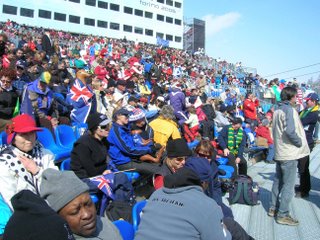 Today, I drove up to the mountain venue in Sestriere with one of our Athletic Trainers to watch the Disabled Alpine Ski events. Today was a light video taping day, so I wanted to go up and watch some of the Giant Slalom events. Today was the “stands” – athletes with disabilities that allow them to ski upright under their own guidance (as opposed to athletes who compete sitting or with a guide). I’ve done physiological testing a few times a year on this team (sits and stands) since working for the USOC, but this was the first time I’ve seen them compete. Granted, it’s my own fault - I’m too much of a wus in the cold to go stand on a hill for a day to spectate. Well, today I redeemed myself and went out on the hill for a day and watched them compete!
Today, I drove up to the mountain venue in Sestriere with one of our Athletic Trainers to watch the Disabled Alpine Ski events. Today was a light video taping day, so I wanted to go up and watch some of the Giant Slalom events. Today was the “stands” – athletes with disabilities that allow them to ski upright under their own guidance (as opposed to athletes who compete sitting or with a guide). I’ve done physiological testing a few times a year on this team (sits and stands) since working for the USOC, but this was the first time I’ve seen them compete. Granted, it’s my own fault - I’m too much of a wus in the cold to go stand on a hill for a day to spectate. Well, today I redeemed myself and went out on the hill for a day and watched them compete!For those of you who wonder what I do back in the Springs, here’s a little insight into the role of a Sport Physiologist for you. Physiological testing for the Disabled Alpine Ski team consists of a Wingate test and max strength & conditioning testing. A Wingate test is done on a specialized type of stationary bike (or upper body ergometer for the “sits”) and is a test of anaerobic strength. The athlete pedals the ergometer at a steady cadence, we give them a countdown, then we add a certain percentage of his/her bodyweight as resistance (dependent upon level and type of disability), and the athlete cycles all-out for 30 seconds. From that, we can determine absolute and relative total power produced, average power over the 30 seconds, and fatigue rate. Now, you may scoff at 30 seconds, but a Wingate test is pretty tough and usually produces near-maximal heart rates, lots of lactic acid, and in some cases, a substantial amount of nausea! Although it may seem like it, this test isn’t just for kicks to torture the athletes. The test results are used by the coach to monitor progress over a season or multiple seasons and to alter training programs. The athletes aren’t particularly fond of the test, but they like getting the results, especially when it shows improvement over the last season!

So, I froze out on the hill (although everyone else was quite comfortable on this bright, sunny day), and watched our “stands” compete. I also went up the gondola into the Italian Alps for a great view of the mountains and the town of Sestriere. At the top, a Chinese Paralympian and his friends wanted to have their pictures taken with the American. We couldn’t speak a lick of each others’ language, but it’s pretty cool that most of these athletes just want to share the experience of these Paralympics with everyone – without regard for nationality or role in the Games. Most of the athletes’ families were cheering just as loudly for all the other athletes as for their own. I have to admit, I shook my spectator cowbell for every athlete that came down the hill, not just for the Americans. The stands were packed, so it was a lot of fun to be a part of so much positive energy at once.

Just another day at the Games!
No comments:
Post a Comment